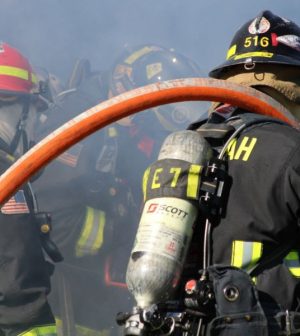- Navigating Your Midlife Crisis: Embracing New Possibilities
- City Raccoons Showing Signs of Domestication
- Mapping the Exposome: Science Broadens Focus to Environmental Disease Triggers
- One Week Less on Social Media Linked to Better Mental Health
- Your Brain Changes in Stages as You Age, Study Finds
- Some Suicide Victims Show No Typical Warning Signs, Study Finds
- ByHeart Formula Faces Lawsuits After Babies Sickened With Botulism
- Switch to Vegan Diet Could Cut Your Greenhouse Gas Emissions in Half
- Regular Bedtime Does Wonders for Blood Pressure
- Dining Alone Could Mean Worse Nutrition for Seniors
Volunteer Firefighters Have High Levels of Potentially Toxic Chemicals

Volunteer firefighters have higher levels of so-called “forever chemicals” in their bodies than the general population does, a new study finds.
It also found that levels of these potentially toxic per- and polyfluoroalkyl substances (PFAS) in volunteer firefighters’ bodies rise with years of service.
PFAS are found in everyday items like electronics and carpeting, and they have been linked with heart disease and other health conditions that strike firefighters.
In this study, researchers from Rutgers University in New Jersey examined levels of nine PFAS chemicals in the blood of 135 members of an N.J. volunteer fire department, and compared them to the general public.
Levels of two PFAS — perfluorododecanoic acid (PFDoA) and perfluorodecanoic acid (PFDA) — were higher in the volunteer firefighters.
“Notably, we found PFDoA levels in 80% of the firefighters, but little in the general public,” said study author Judith Graber, an associate professor at Rutgers School of Public Health.
Higher chemical levels were associated with the number of years of firefighting. On average, the firefighters in the study had 20 years of experience.
The study was published recently in the International Journal of Environmental Research and Public Health.
Volunteer firefighters represent more than 65% of the U.S. fire service.
“The primary cause of line-of-duty death among firefighters are heart attacks. They also get and die from many types of cancer more often than other people,” Graber said in a Rutgers news release.
“More than 95% of the U.S. population have these chemicals to some degree in their bodies, but firefighters have heightened exposure to PFAS through their protective gear and fire suppression foam and the burning materials they encounter that release particles, which can be inhaled or settle on gear and skin,” she explained.
“Further research is needed to better understand the sources of these chemicals and to design effective foam and protective clothing that do not use these chemicals,” Graber said.
More information
There’s more on PFAS at the U.S. Centers for Disease Control and Prevention.
SOURCE: Rutgers University, news release, May 3, 2021
Source: HealthDay
Copyright © 2025 HealthDay. All rights reserved.










